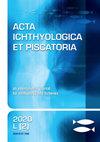Effect of dietary lipid levels on growth, body composition, and enzyme activities of larvae of butter catfish, Ompok bimaculatus (Actinopterygii: Siluriformes: Siluridae)
IF 1
4区 农林科学
Q3 FISHERIES
引用次数: 2
Abstract
The Indian butter catfish, Ompok bimaculatus (Bloch, 1794), is a high-value catfish that has gained immense consumer preference in South-East Asia. However, information on the nutritional requirements of this species is scanty. Hence, an experiment was conducted to evaluate the effects of varying dietary lipid levels on growth, body composition, and activities of digestive and metabolic enzymes in larvae. Three isonitrogenous (40% crude protein) diets were formulated by supplementing fish and vegetable oil (1:1) at 4.5% (D1), 7% (D2), and 9.5% (D3) levels (containing crude lipid 5.7%, 8.0%, and 10.45%, respectively in diets D1–D3) to a fish meal- and oilcake-based formulated diet. Experimental diets were fed to butter catfish larvae (0.15 ± 0.01 g) in triplicate groups for a period of 42 days. Proximate compositions of the experimental diets, as well as fish carcass, were analyzed using standard procedures (AOAC 2005). Digestive and metabolic enzyme activities were analyzed at the completion of the experiment by standard methodology. Butter catfish larvae fed the diet D2 (8% crude lipid) resulted in the best performance in terms of weight gain (final weight 1.40 ± 0.07 g), net weight gain (1.31 ± 0.06 g), specific growth rate (5.50 ± 0.05% · day−1), and protein efficiency ratio (2.39 ± 0.17). The highest lipid deposition (2.90 ± 0.12%) in the carcass was also recorded in fish reared on diet D2. The final weight, net weight gain, protein efficiency ratio, and specific growth rate were significantly (P < 0.05) higher in D2 having 8% lipid. Moisture and lipid contents of the whole body were significantly (P < 0.05) higher in larvae fed diet D2. Amylase activity in fish significantly (P < 0.05) decreased with increasing dietary lipid levels. The maximum alkaline protease, pepsin, and lipase activities were noticed in the larvae fed diet D2. Progressive decrease in liver glucose-6-phosphate dehydrogenase activities and significant increase (P < 0.05) in the activities of neoglucogenic enzymes (glucose-6-phosphatase and fructose-1,6-bis phosphatase) were noticed with an increase in dietary lipid levels. Significantly lower (P < 0.05) activities of LDH, ALT, and AST were recorded in the group fed diet D2. Results of the study indicated that 8% crude lipid in the diet could assure optimum growth and survival of butter catfish larvae during early development. An appraisal on growth, body composition, and digestive as well as metabolic function in the butter catfish larvae recorded in the study might provide some important information to consider application of formulated diets for the larviculture of Ompok bimaculatus.饲料脂肪水平对双马尾油鲶(Ompok bimaculatus)幼鱼生长、体成分及酶活性的影响
印度黄油鲶鱼Ompok bimaculatus(Bloch,1794)是一种高价值的鲶鱼,在东南亚获得了巨大的消费者偏好。然而,关于该物种的营养需求的信息很少。因此,进行了一项实验来评估不同膳食脂质水平对幼虫生长、身体组成以及消化和代谢酶活性的影响。通过在以鱼粉和油饼为基础的配方日粮中添加4.5%(D1)、7%(D2)和9.5%(D3)水平的鱼和植物油(1:1)(在日粮D1–D3中分别含有5.7%、8.0%和10.45%的粗脂质),来配制三种等氮(40%粗蛋白)日粮。实验日粮喂养黄油鲶鱼幼虫(0.15±0.01g),一式三组,为期42天。使用标准程序(AOAC 2005)分析了实验日粮的近似成分以及鱼体。实验结束时,用标准方法分析消化酶和代谢酶的活性。在增重(终重1.40±0.07g)、净增重(1.31±0.06g)、比生长率(5.50±0.05%·day−1)和蛋白质效率比(2.39±0.17)方面,饲喂饲料D2(8%粗脂)的鲶鱼幼虫表现最佳。在含8%脂质的D2中,终重、净增重、蛋白质效率比和比生长率显著升高(P<0.05)。投喂D2饲粮的幼虫全身水分和脂质含量显著高于投喂D2的幼虫(P<0.05)。鱼类淀粉酶活性随日粮脂质水平的升高而显著降低(P<0.05)。饲喂D2的幼虫碱性蛋白酶、胃蛋白酶和脂肪酶活性最高。随着膳食脂质水平的增加,肝脏葡萄糖-6-磷酸脱氢酶活性逐渐降低,新产糖酶(葡萄糖-6-磷酸酶和果糖-1,6-双磷酸酶)活性显著增加(P<0.05)。饲料D2组的LDH、ALT和AST活性显著降低(P<0.05)。研究结果表明,日粮中8%的粗脂可以保证鲶鱼幼虫在发育早期的最佳生长和存活。对研究中记录的黄油鲶鱼幼虫的生长、身体组成、消化和代谢功能进行评估,可能会为考虑将配方日粮应用于双斑斑鱼幼虫养殖提供一些重要信息。
本文章由计算机程序翻译,如有差异,请以英文原文为准。
求助全文
约1分钟内获得全文
求助全文
来源期刊

Acta Ichthyologica Et Piscatoria
FISHERIES-ZOOLOGY
CiteScore
2.20
自引率
0.00%
发文量
31
审稿时长
>12 weeks
期刊介绍:
ACTA ICHTHYOLOGICA ET PISCATORIA (AIeP) is an international, peer-reviewed scientific journal that publishes articles based on original experimental data or experimental methods, or new analyses of already existing data, in any aspect of ichthyology and fisheries (fin-fish only).
 求助内容:
求助内容: 应助结果提醒方式:
应助结果提醒方式:


